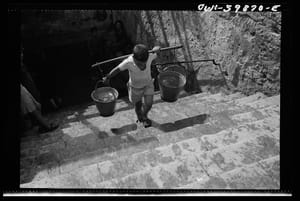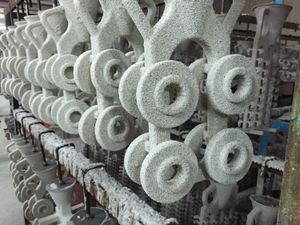It's Friday, and as usual I've got an assemblage of relevant and worthwhile things that fall just a little bit short (or a little bit outside) of a full writing assignment. Scope creep! Let's get at it.
SCOPE CREEP.
- My notes on three books I've read recently.
- A detailed description of what it takes to create fonts for math typesetting, which can have up to 6,000 individual glyphs.
- The Bridges conference, which covers "mathematical connections to art, music, architecture, and culture," is being held in Richmond, Virginia the first week of August.
- A fairly detailed blog post on how fire hydrants are tested and maintained in Sebastopol, California.
- Last week I got an email from Reilly Brennan, who asked:
My son, who is turning 8 next week, has been on a diy building/making kick that started when he was about 5. He races through Legos quickly (eventually I have moved him to Tamiya glue models, mostly to give him a better challenge, they are cheaper, etc). He really loves building stuff with cardboard that he finds from our Amazon scrap pile. I bought him one of those yellow canary knives you recommended a while back. I am just wondering what would be a next step for him that would give him a challenge, while not slowing down/tamping his enthusiasm? Is it 3D printing? Is it something else? I am kind of at a loss for what to do next with him, and I love that these things have been screen-free to date.
My house is filled with his cardboard projects (a pirate ship, go-kart aero wings, etc). Help me.
My response, which feels relevant to this newsletter, is below:
This may be a little forward-looking, but before too long it might be interesting for him to start taking other peoples' designs apart. I don't think I really started doing this until high school, when I took an auto shop class and tore down my family's lawn mower. The mower was, alas, never the same, but on the bright side I don't think that I was never the same either. At some point around then I believe I also took apart a bike, which as you know is to this day my preferred mechanical assembly, though I can't recall why or whether this particular velocipede ever functioned properly again.
Regardless, I would suggest some tools. A set of electronics screwdrivers might be interesting; perhaps one of the iFixit sets, which are all nice. Then just give him an old cell phone or an alarm clock and, minding the batteries, let him tear it apart and try to put it back together again. At first this might not seem like as creative an activity as Lego and Tamiya and cardboard, but actually I think it's quite similar, and it's fun seeing different materials and manufacturing methods coming together into a single, complex, assembly. He'll probably develop a better sense of how things actually work, and will start to understand the degrees of freedom that product engineers have when they're not starting with uniform, modular building systems like Lego.
As for 3D printing: I've showed my kids 3D printers in the past, but it wasn't as exciting as I might have hoped. This was SLA, which is particularly slow to watch, and it's possible that FDM (which is generally also cheaper) would be more engaging. But, the fun with 3D printing really only starts when you develop some 3D modeling chops, and that requires putting your kid back in front of a screen, and also teaching them about the design constraints of the medium, and ALSO making sure they don't fall back into Roblox or whatever. Not that there's anything wrong with those things, but to me they feel like a distraction from the main thread, which is to empower the kid to explore how objects interact in three dimensional space.
I think the other work stream, which was also really influential for me, is to show him that you really can make things that you then use every day. I think I started taking wood shop class around seventh grade, and over a year or two I made a shelving unit and a simple wooden gumball machine. Those were fine, but they were more fathers' day gifts than anything else. But a few years later, I decided to build myself a bed. I learned a little AutoCAD, drafted the bed's core elements, and eventually worked with a woodworker to build it. It was really empowering – the bed hung from the ceiling on braided sailing line, and we installed a whole block and tackle in the attic above my room so that the bed could be raised off the floor. I'm not totally sure how to encourage this path, but I think it has to do with looking around your house and trying to find something that's imperfect, then imagining how it could be improved. Maybe it's just a modification, but maybe it's a full redesign; either way, he should come away with more than a desk toy or shelf trinket.
Hope that helps! Send pictures :)
(And if you're reading this and have your own suggestions, put them in the comments by clicking the button at the bottom of this email!)
- To close this week's Scope Creep, I wanted to share two of my own personal favorite entries from the Campionato Mondiale di Umari. This was from Sam Watters, and struck me as a wonderful moment:
"What's that noises?"
That beeping? That’s the noise trucks sometimes make
When they go backwards
Look, those big shovels are back, should we go see them?
Whoa, look at those trucks, look at those big piles of dirt
There is a man in that big hole, see? He has a shovel
See the hole? It’s long, from the street all the way back to that house
That yellow pipe, see? They dug a long hole for the pipe.
Remember how we talked about pipes under the ground?
The pipes are filled with water, the water comes out of the faucet and the shower.
What do you see?
Yellow shirts, that’s right, so bright, what else?
Big truck, that’s right, what’s in there?
That stuff is tools, see? It’s like a workshop that they bring around
Like our basement, they have all their tools.
They’re digging holes all down this street, they’re helping
The people who live here stay safe, they make sure the pipes aren’t broken.
It’s loud, I know, but fun to watch, ok, let’s keep going.
- And lastly, from Dominic Mason, an entry to the Campionato whose tension is established quickly before being gently and gracefully released into collaboration:
“It will block the sun,” she exclaimed.
“I don’t know, it’s only three storeys. We need a new health centre, the car parking will improve visitors to the gallery, and the schools will have somewhere convenient to refer sick children,” I offered.
“The. Sun. Will. Be. Blocked.” She sharpened every word before delivery.
I mulled before responding. “We may get less sun, but there are patches on the lawn anyway, and the trees get bleached in August. I bet they will have flowers out the front. Many civic projects now have to have wild flower beds surrounding them. Bees on the roof maybe?”
“What shall we do?” She stood up, the brightness of a low winter sun behind her, outlined against the window, as if gripped by a shamanic state. She grasped the teapot threateningly.
In awe, like an ape observing a grape picking machine, I offered the only obvious response: “Let’s email the Council, together. There was a poster on the lamp post opposite?”
Placated, for now, she sat back down. “Let’s do that, together… how do you measure sunshine?”
Thanks as always to Scope of Work’s Members and Supporters for making this newsletter possible. Thanks also to David, Tony, and Charlie for helping source links this week.
Love, Spencer
p.s. - We care about inclusivity. Here’s what we’re doing about it.



